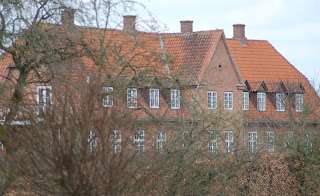Daugård church, Hatting herred, Vejle amt
10 km northeast of Vejle
The large white-washed church in Daugård has a Romanesque choir and nave with late Gothic additions: a tower to the west and a porch to the south. The Romanesque building is in travertine upon a vaguely marked plinth. The choir and nave have partly kept their original wall-decorations with lisens and round arch friezes in two storeyes and with narrow lisen-bands around the bricked-up windows. The round arched south door is in use, while the north door is almost gone. The choir arch seems expanded in the late Gothic period and like the eastern part of the choir rebuilt in monk bricks; the gable has lisens, which continue in the gable-triangle with round arches, a Romanesque mark, which is also found in Engum church and several other buildings in East Jutland. In the choir was built a cross-vault with ribs, in the nave three cross vaults upon protruding wall-pillars. From the same period is the west tower, which cross-vaulted bottom room opens in full broadth towards the nave in a pointed arch. The smooth gables are rebuilt, probably in a thorough repair in 1792. The late Gothic porch has a stepped gable with seven roundarched high-glares and small cross-glares.
 |
| house in Daugård |
Upon the north wall of the choir were in 1956 found fragmentaric Romanesuq frescoes from ab. 1200. They were cleansed in 1960. At the choir arch are vine-frescoes from the Reformation-period. The altar piece is a typical work by Jens Hiernøe from ab. 1800 with corintich pillars, vases and symbols. In the big field a painting from the late 1800s, a copy of Carl Bloch's Gethsemane. Chalice from 1692. Late Gothic ore candelabres. A fine Romanesque font with lions with characteristic manes, reflecting ornaments from the Viking period and connecting it to fonts in Ejstrup and Nr. Snede church. A south German bowl from ab. 1575. A pulpit in simple Renaissance from ab. 1610 with Tuscany corner pillars, repaired in 1939. A sounding board in acanthus Baroque from the 1700s. A new model of a five-master bark. Bell by Gamst from 1815. In the north wall of the choir a Romanesque granite grave stone with majuskel inscription: ACERUS CAPELAN JACET HIC.
 |
| Williamsborg |
 |
| old railway bridge, Tirsbæk |
Bryskesborg (1664 Bryschisborig)was founded from some desolate farms by Lisbeth Bryske of Tirsbæk (+ 1673), in 1661 it was desolate and broken down, and in 1684 gave Steen Bille it to Rasmus Nielsen, absolutely free for the rest of his life, if he in return would build the outbuildings, while Steen Bille built a farmhouse. The estate had joint owner with Tirsbæk, until Jørgen Hvass de Lindenplalm in 1774 endowed it to his son-in-law William Halling, later of Dronninglund, who in 1775 had royal grant to call it Williamsborg. He sold it to Chr.Kallager, who in 1784 endowed it to Joh. Fr.v.Schmidten (+ 1830). After having sold most of the farm estate Williamsborg was endowed with Daugård parish's royal- and church-taxes and estate in 1810 to Jeremias Müller Secher, who in 1824 endowed it to Niels Emanuel de Thygeson of Bygholm. Then W. came in 1827 to Carl Gustav Lillienskjold (+ 1830 ), whose heirs in 1837 sold it to Carl Henrik Martini ( + 1860), whose widow Margrethe Frederikke Bevensee owned it until her death in 1890, after which the heirs sold it to A.P. Frederiksen of Elkærholm. After his death in 1901 the heirs sold W. in 1902 to baron Hans Rudolph Gustav Wedell-Wedellsborg (+ 1954), whose widow in 1961 sold it to S.E.J. Broholm, Broholmgård, Fyn.
The original Bryskesborg is unknown, after the Swedish wars was it demolished. In 1774-75 built William Halling the present main wing. The side wings are probably newer. The building is listed in class B. The large three-winged ladegård (farm buildings) was rebuilt after a fire in 1912.
 |
| house, Tirsbæk |
Daugård belonged in 1719 to Joh. Ludvig v. Müllen (+ 1750), then to his son Jakob v. Müllen (+ 1779), after whom it was bought by his son Joh. Ludvig v Müllen (+ 1808). It belonged later to his widow, Catherine Dorthea Utzon (+ 1829), and in 1829 it was endowed by Niels Emanuel de Thygeson of Bygholm to J.P With. In 1850 it belonged to Th. Ernst and was in 1858 at an auction of his bankruptcy sold to P.Bay (+ 1865) Rudkøbing, whose son-in-law Vilh.Chr. Barner (+ 1902) in 1866 sold it to J.B. Krarup (+ 1898), who moved his agricultural school from Skårupgård to Daugård. The school was abandoned in 1874, and the farm was sold the same year to F.A. Søltoft of Lerbæk (+1883), whose heirs sold it to Frantz Jørgen Ahlman (+ 1915), whose son-in-law Chr. E. G. Lunding took it over in 1916 and sold it in 1928 to H. Ude Hansen, whose son Niels Ude-Hansen was the owner in 1964.
Names in the Middle Ages and the 1600s:
Daugård (1399 Daghægord, 1446 Dawgord); Askebjerg (1664 Aesbierre).
Listed prehistorics: a long dolmen, where the cover stone has many hollows, a passage grave with a hexagonal chamber of 7 supporting stones, but no cover stone.
Demolished or destroyed: 2 long dolmens, 2 passage graves and 7 other stone graves. 27 hills, mostly to the west and south of the parish. In a passage grave at Skovlys' land were found 3 flint axes and 2 flint daggers.
Source: Trap Danmark, Vejle amt, 1964.
photo Daugård & Williamsborg 2008: grethe bachmann


No comments:
Post a Comment